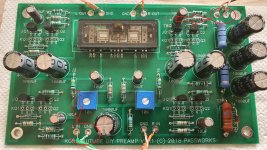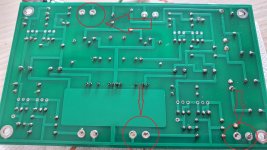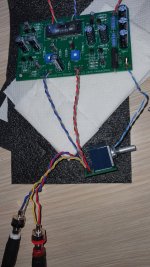Picture in post #7576 does not show the solder joints clearly nor does it show the bottom side of the board. Solder joints of Nutube to board are not clear in the pictures. Have a close look at those joints and re-solder any joints that look suspect.
Again, did you ground the body of the volume control?
Also try a different amplifier.
Also try a different source.
Need to eliminate variables.
Again, did you ground the body of the volume control?
Also try a different amplifier.
Also try a different source.
Need to eliminate variables.
Post #7,569, it show soldering clearly there.Picture in post #7576 does not show the solder joints clearly nor does it show the bottom side of the board.
Again, did you ground the body of the volume control?
Also try a different amplifier.
Also try a different source.
Need to eliminate variables.
Haven't grounded it, it's on the table and i haven't used the box yet (to be made). I can probably get some makeshift alu box soonish to try it. Until then, where to ground the vol pot/board?
New amp i can try this weekend, perhaps thursday. Same goes for source.
.............
Looking at your board (post #7569) there are some solder joints that look a bit rough. One such joint is the V+ to the board. The line in and line out and ground wire connections to the board look rough too.
I was looking at #7569, but in your following post you said that you resoldered, so I wasn't sure whether the photo of #7569 was still current.I've just resoldered wiring including connections on alps, removed p089zb filter. ..........................
The body of the volume pot should be grounded. Probe the body of the pot and board ground with you meter. If it shows high resistance then connect a wire to the body of the pot and the other end to the power supply ground point on the board.
Yes i've resoldered wiring but not components (only replaced now 270r resistor to 5w dale). Don't know if there is some issue there.I was looking at #7569, but in your following post you said that you resoldered, so I wasn't sure whether the photo of #7569 was still current.
The body of the volume pot should be grounded. Probe the body of the pot and board ground with you meter. If it shows high resistance then connect a wire to the body of the pot and the other end to the power supply ground point on the board.
I've just grounded the pot, first at the bolt location at the edge with a screw and nut, then soldered directly to power supply ground point and still nothing. I recoded the sound it produces at three spots in this order tweeter, midrange, woofer. It's in the attachment.
That hiss and bzzz more towards the woofer. Bzzz gets louder the louder i turn the pot, but the hiss stays the same volume.
Attachments
Doesn't sound like hum. Sounds like hiss with a steady beat. Is this from both channels? Perhaps a bad power supply connection? Motorboating?
Is that with with a source connected to the input and playing music? What is the sound with no source connected to the input but with the input shorted (temporarily connect the input + to ground)? If you play music is there music from the output in addition to the hiss and buzz?
What power supply are you using?
Some not so good looking solder joints:
Is that with with a source connected to the input and playing music? What is the sound with no source connected to the input but with the input shorted (temporarily connect the input + to ground)? If you play music is there music from the output in addition to the hiss and buzz?
What power supply are you using?
Some not so good looking solder joints:
Attachments
@Ben Mah that beat/motorboating is heard from left channel only.
I've shorted inputs and it is the same. Without source connected also.
Yes when i play music it plays on output with addition of hiss and buzz.
Power supply is the one from the kit.
I have resoldered those, but i can do it again.
I've shorted inputs and it is the same. Without source connected also.
Yes when i play music it plays on output with addition of hiss and buzz.
Power supply is the one from the kit.
I have resoldered those, but i can do it again.
That's progress! So the hiss and buzz is left channel only? It may be a bad solder joint or joints in the left channel.
Since the noise was still there when the inputs were shorted, that most likely rules out the source as the problem. Just to rule out the amplifier, switch the left and right channels at the preamp OUT jacks. If the noise and hiss shift to the right speaker then the amplifier is not the problem.
I suggest then to redo all of the preamp left channel solder joints.
Since the noise was still there when the inputs were shorted, that most likely rules out the source as the problem. Just to rule out the amplifier, switch the left and right channels at the preamp OUT jacks. If the noise and hiss shift to the right speaker then the amplifier is not the problem.
I suggest then to redo all of the preamp left channel solder joints.
Had the same issue. Sold mine. 
ACP+ rules.
not Papa’s fault. Imho, the Korgs are complete rubbish.
Some even report ringing using Millets solution…
edit: maybe that was a bit harsh… sound was completely lovely. But ringing irritated me, and I found it impossible to get rid of hiss/buzz. Could not find errors in my own work. That’s not to say there weren’t any. New owner was very happy, so maybe it was my setup.

ACP+ rules.
not Papa’s fault. Imho, the Korgs are complete rubbish.
Some even report ringing using Millets solution…
edit: maybe that was a bit harsh… sound was completely lovely. But ringing irritated me, and I found it impossible to get rid of hiss/buzz. Could not find errors in my own work. That’s not to say there weren’t any. New owner was very happy, so maybe it was my setup.
Last edited:
If it is both channels it is possible that the power supply itself or the power supply components on the board may be causing the problem. I have very little experience with switching supplies.
I used to play with tube preamplifiers and amplifiers and have experience hiss with them, and it was usually a problem with a tube.
Buzz may be a bad connection or solder joint or possibly a grounding issue.
Have you redone the solder joints that I pointed out in post #7,585? If not then do them. The larger solder joints need more heat than the small joints. Is the power output of your soldering iron adjustable for more heat?
Also have a close look at the Nutube solder joints. At this point have a close look at all joints. The solder should be smooth and shiny.
I used to play with tube preamplifiers and amplifiers and have experience hiss with them, and it was usually a problem with a tube.
Buzz may be a bad connection or solder joint or possibly a grounding issue.
Have you redone the solder joints that I pointed out in post #7,585? If not then do them. The larger solder joints need more heat than the small joints. Is the power output of your soldering iron adjustable for more heat?
Also have a close look at the Nutube solder joints. At this point have a close look at all joints. The solder should be smooth and shiny.
Yes, i have literally changed to different wires, suctioned solder from those joints, cleaned, resoldered. All shiny and well filled. Yes, i use solid soldering station (ksger t12 stm32) and use different tips and heat depending on the size of solder joints. I will take a look at all component joints tomorrow. I'll get mean well rs-25-24 and give it a go before resoldering each and every component on board 😅
I tested mine with two supplies of the same stock type as prescribed: one from the kit, and one I ordered myself. Exactly the same contribution of extra hiss into the system. Like I said, I never did find the real source of the problem. And all joints good…If it is both channels it is possible that the power supply itself or the power supply components on the board may be causing the problem. I have very little experience with switching supplies.
I used to play with tube preamplifiers and amplifiers and have experience hiss with them, and it was usually a problem with a tube.
Buzz may be a bad connection or solder joint or possibly a grounding issue.
Have you redone the solder joints that I pointed out in post #7,585? If not then do them. The larger solder joints need more heat than the small joints. Is the power output of your soldering iron adjustable for more heat?
Also have a close look at the Nutube solder joints. At this point have a close look at all joints. The solder should be smooth and shiny.
but then I have never been the master of complete silence. That master is non other then Ben Mah 🙂
hope you get there.Yes, i have literally changed to different wires, suctioned solder from those joints, cleaned, resoldered. All shiny and well filled. Yes, i use solid soldering station (ksger t12 stm32) and use different tips and heat depending on the size of solder joints. I will take a look at all component joints tomorrow. I'll get mean well rs-25-24 and give it a go before resoldering each and every component on board 😅
Though, looking at your work, and seeing as you actually made a working version of this circuit before, if Ben’s advice doesn’t get you there, maybe a Nutube massage is in order. A soft one. If it doesn’t work, no damage will have been done, and you will have practiced your massage skills instead of killing your soldering tips.
I hope that this doesn't end up being the same case, as i already feel i wasted 350$ and boat load of nervs 🙂 BUT i'm fighting for it 😅And i don't want to recall what i gifted, so it better work xD. Tube itself is non microphonic so at least theres that. I don't mind if i manage this to end up with a little hiss/humm w/e at ear distance, but honestly not at listening position.
I am very, very interested in the solution for this issue. Sounds like just the same problem I had 🙂I wasn't lazy and i've resoldered every one of those suckers on board. All nice clean shiny joints. And still it hisses. Waiting for the new supply now, ordered mw rs 25 24.
The output at the plate is quite high impedance, which is why we buffer it with a jfet before sending it out into the world. This makes for opportunities for noise picked up from the environment, noise from the load resistor and possibly high frequency oscillation. For the latter you can explore some gate resistance for the jfet or some small capacitance (pf) attaching the plate to somewhere else.


@Nelson Pass first one i built had no issue in same enviroment. Does that mean that jfets or nutube itself is somewhat faulty?
I'll box it in aluminum case thats arriving tomorrow, and new supply should come also. So we rule that out.
I'll box it in aluminum case thats arriving tomorrow, and new supply should come also. So we rule that out.
- Home
- Amplifiers
- Pass Labs
- B1 with Korg Triode



